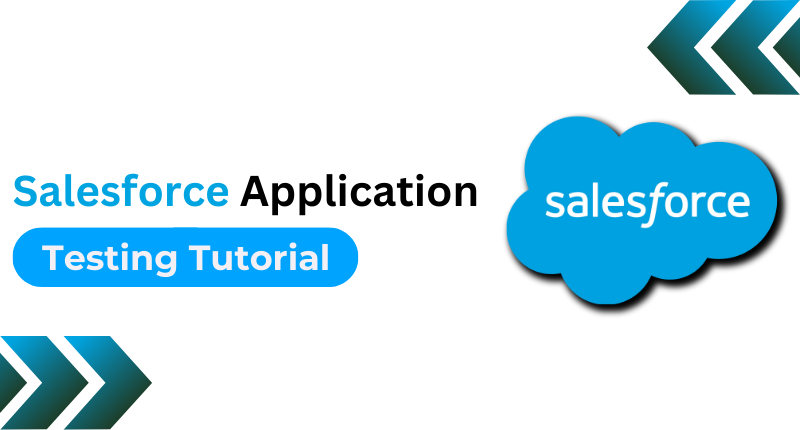Salesforce is a powerful platform for building custom applications that streamline your business processes and improve customer engagement. However, no matter how well you design your Salesforce application, it’s crucial to ensure it functions as expected, is secure, and meets your business requirements. This is where comprehensive testing comes into play. In this blog, we’ll take you through the various types of testing you should consider when developing a Salesforce application.
1. Unit Testing
First and foremost, unit testing serves as the foundation of any solid testing strategy. In Salesforce, you write unit tests in Apex, the platform’s programming language. Unit tests are used to verify that individual pieces of code (e.g., triggers, classes, and methods) perform as expected. They help catch bugs early in the development cycle.
To conduct unit testing in Salesforce, follow these steps:
- Writing Test Methods: Begin by writing test methods for your code.
- Test Execution: Execute the test methods using Salesforce’s built-in testing framework.
- Results Analysis: Analyze the results to identify and fix any issues.
2. Integration Testing
Salesforce often integrates with external systems, such as other databases or APIs. Integration testing ensures that these connections function correctly. Consider the following for integration testing:
- Testing the Interaction: Test the interaction between Salesforce and external systems.
- Data Synchronization: Verify data synchronization.
- Handling Changes: Assess the impact of changes in external systems on your Salesforce app.
3. User Acceptance Testing (UAT)
User acceptance testing is vital to confirm that your Salesforce application meets your business requirements and aligns with user expectations. Engage the end-users or stakeholders in this process. Steps for UAT include:
- Test Case Definition: Define test cases based on business requirements.
- User Involvement: Involve end-users to execute test cases.
- Feedback Gathering: Gather feedback and make necessary adjustments.
4. Security Testing
Ensuring the security of your Salesforce application is paramount, especially when handling the sensitive data. Security testing includes a range of essential activities:
- Penetration Testing: Conduct penetration testing to identify vulnerabilities within your application.
- Code Scanning: Employ code scanning tools to find and rectify security flaws present in your codebase.
- Data Access Control: Implement and rigorously test data access and sharing rules to maintain data security and confidentiality.
5. Performance Testing
To ensure your Salesforce application can handle expected user loads, conduct performance testing. Key aspects of the performance testing include:
- Testing with Performance Suite: Testing using Salesforce’s Performance Testing Suite.
- Benchmarking and Analysis: Benchmarking and analyzing results.
- Performance Improvement: Making necessary performance improvements.
6. Regression Testing
Regression testing is essential for catching new issues that may arise after updates or changes to your Salesforce application. Automation is particularly useful for this type of testing. Key steps are:
- Test Suite Creation: Creating a comprehensive test suite.
- Automation Emphasis: Automating tests where possible.
- Regular Testing: Running regression tests regularly after changes.
7. User Interface (UI) Testing
The user interface is what users interact with directly, making UI testing vital. Consider the following for UI testing:
- UI Friendliness: Testing the UI to ensure it’s user-friendly.
- Responsive Design: Checking for responsive design on various devices.
- Component Verification: Verifying that UI components function as intended.
8. Mobile Testing (if applicable)
If your Salesforce application has a mobile component, ensure it works seamlessly on different devices and operating systems. Mobile testing involves:
- Device Diversity: Testing on various mobile devices and OS versions.
- Mobile Features: Ensuring mobile-specific features (e.g., touch gestures) work properly.
- Responsive Design: Verifying responsive design for different screen sizes.
9. Data Migration Testing
Data migration testing is essential when moving data into or out of Salesforce. Consider these steps:
- Planning and Documentation: Planning and documenting the data migration process.
- Quality Assurance: Running tests to ensure data quality and integrity.
- Data Accuracy: Verifying that data is accurately migrated.
10. User Training and Documentation
Training and documentation are often overlooked aspects of testing. Include these steps in your testing strategy:
- Guide and Documentation Creation: Create user guides and documentation.
- Training Sessions: Provide training sessions to familiarize users with the application.
- User Involvement: Involve users in the training process to gather feedback.
In conclusion, a robust testing strategy is fundamental to the success of your Salesforce application. Testing not only ensures that your application functions correctly but also helps identify and mitigate security risks, performance bottlenecks, and UI issues. By following the steps outlined in this guide, you can create a comprehensive testing plan that aligns with your development process and leads to a more successful Salesforce application.
References:
- Salesforce Developer Documentation
- OWASP Salesforce Security Best Practices
- Salesforce Testing Best Practices
Happy testing!




